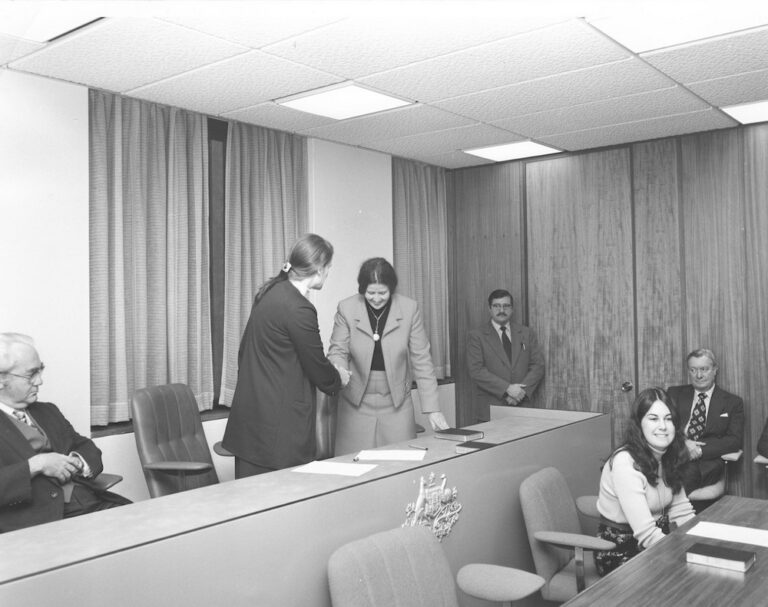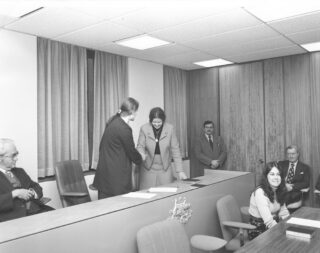- Entry type: Person
- Entry ID: AWE5624
Maxwell, Josephine
- Honourable Justice

- Occupation Judge, Lawyer, Solicitor, Tribunal Member
Summary
In June 1976, Josephine Maxwell was one of four women appointed to the Bench of the then brand new Family Court of Australia, which was headed by its first Chief Judge Justice Elizabeth Evatt.
Go to ‘Details’ below to read a reflective essay written by Josephine Maxwell for the Trailblazing Women and the Law Project.
Details
The following additional information was provided by Hon. Josephine Maxwell and is reproduced with permission in its entirety.
In June 1976, I was one of four women appointed to the Bench of the then brand new Family Court of Australia, which was headed by its first Chief Judge Justice Elizabeth Evatt.
I came from the Solicitors’ branch of the Profession and my appointment and that of Bryce Ross-Jones made at the same time, was the first time that a Solicitor had been appointed to the Bench in New South Wales.
At the time of my appointment, I was thirty-eight, and a sole practitioner practising under the name of T.J. McFadden, Maxwell & Co, in the Trust Building on the corner of King and Castlereagh Streets, Sydney. Teague Joseph McFadden had been my ‘Master Solicitor’ when I commenced five-year articles in April 1955. When he died on 18 July 1970 he bequeathed me his legal practice, which I then amalgamated with my own practice.
At the time of my appointment in 1976 I was conducting this practice with the assistance of an employed solicitor and clerical staff, and undertaking work in conveyancing, probate, divorce (as Family Law was then classified) and other litigation as it arose. Many of my clients had been clients of the firm since my articled clerk days.
As well as running a busy and varied practice I was mother of three children, who were 16, 15 and 12 at the time of my appointment. My husband Frederic, whom I had married in 1959, was at that time a property lawyer with the Commonwealth Crown Solicitor’s office in Sydney.
Upon my swearing-in on 21 June 1976 I sat at the Sydney Registry of the Court, then operating at 220 George Street Sydney. There was no time for preliminaries such as judicial education – one was sworn in at 4 pm one afternoon and had a substantial list the next day, as the volume of work coming into the Court was enormous.
A few months later I went to sit at the brand new Parramatta registry of the Court. This building had been erected as commercial premises and was at the end of Charles Street adjacent to the Parramatta River, close to where the ferry wharf now stands. The Parramatta River was a very different sight then from today. It was dirty, muddy rocky and decorated with abandoned car bodies. The Senior Judge was Raymond Sanders Watson, one of the architects of the controversial Family Law Act of 1975.
The extraordinary difficulties and history of the development of this brand new and innovative Court, conceived in the era before 11 November 1975 and painfully born in quite a different era on 5 January 1976, have been discussed at some length in ‘Born in Hope-The Early Years of the Family Court of Australia’ by Shurlee Swain and need not be further explored here. Suffice it to say that it was a most interesting time. It was exciting and a privilege to be part of this large and disparate group of people, judges and other personnel from various disciplines, brought together in a Court setting for the first time.
Most were enthusiastic and focussed on making this brand new Court work under difficult circumstances, including antagonism from sections of the legal profession, the media and others. On the other hand, with few exceptions, the legal practitioners in this new and controversial setting rallied around to make it work.
Rules, procedures and precedents had to be developed ‘from scratch’, and the Court was absolutely deluged with clients from its opening day. Many of these people had been waiting for years for this new ‘no fault’ divorce court and hundreds had their cases transferred to the new Court from the Supreme Courts, which had previously had jurisdiction over matrimonial matters.
I was particularly attracted to the ‘no fault’ ground because as a solicitor I had seen at first hand the distress of parties in failed, sometimes violent and destructive, marriages who had to fit the details of their unhappy situations into one of the bases of fault such as cruelty, desertion or adultery. However I do think there may have been some basis for making the required period of separation two years instead of one year. Perhaps the ardent critics might have found that more acceptable.
While the public may have been focussed on the changed ground for divorce, there were many other changes introduced by the Family Law Act. It put beyond question that the welfare of the child was paramount in relation to all matters involving children. Most significantly, and certainly for the first time in this country, there were appropriately qualified counsellors, either psychologists or social workers, working within the Court framework. Their work involved not only counselling parties about custody and access (as the issues were then called) but also preparing reports for the Court where appropriate in contested cases. These reports, and those prepared by experts on the instructions of children’s representatives, looked at the family structure as a whole, rather than each party producing competing reports by experts who had seen only one side, as had occurred under the old system. This produced a much better outcome from the children’s perspective.
Disputes about property were also dealt with in a more equitable fashion, as the Court could consider contributions other than directly financial and could consider a broad range of factors to produce a fairer result.
In July 1978 I returned to the Sydney Registry then at Temple Court, 99 Elizabeth Street, Sydney and later the Registry moved to purpose built premises in Goulburn Street.
Although appointed for life (life appointments ceased after the amendments to the Constitution in 1977), I retired from the Bench in July 1999 after 23 years on the Family Court Bench.
By this time the vast majority of cases settled either before Court and with or without the assistance of their legal practitioners, or within the Court’s mediation and conciliation services. The five or six per cent of cases that remained in dispute were mostly bitterly fought and full of conflict and contention. Sadly this was proof that human nature cannot be changed by an Act of Parliament, however well intentioned.
For several years after my retirement I sat on the Guardianship Tribunal. Since then I have continued a busy life with a variety of activities, not least of which include my three grandsons.
Digital resources
Published resources
- Book
-
Site Exhibition
- Australian Women Lawyers as Active Citizens, http://www.womenaustralia.info/lawyers/biogs/AWE5624b.htm
